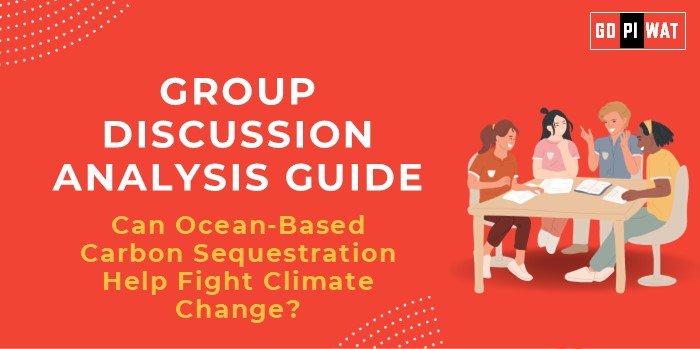📋 Group Discussion Analysis Guide
🌊 Can Ocean-Based Carbon Sequestration Help Fight Climate Change?
🌟 Introduction to Ocean-Based Carbon Sequestration
Context: Climate change is one of the most pressing global issues, necessitating innovative solutions for carbon removal. Ocean-based carbon sequestration, which utilizes the oceans’ capacity to absorb and store carbon, is emerging as a potential climate mitigation strategy.
Background: This technique involves enhancing natural processes like phytoplankton growth, kelp farming, or direct carbon injection into ocean depths. Recent studies estimate that oceans naturally absorb approximately 25% of global CO₂ emissions annually, but engineered solutions could significantly amplify this capacity.
📊 Quick Facts and Key Statistics
- 🌍 Global CO₂ Absorption by Oceans: ~2.5 billion metric tons annually – Demonstrates the natural role of oceans in mitigating climate change.
- 📈 Potential Additional Capture: Up to 1 gigaton of CO₂ per year through enhanced methods – A critical contribution to global emission targets.
- 🔥 Global Carbon Budget: Requires a reduction of 23 gigatons annually by 2050 to limit warming to 1.5°C – Highlights the urgency for novel sequestration techniques.
- 💰 Cost of Ocean-Based Techniques: Estimated at $10-$100 per ton of CO₂ – Competitive with other carbon removal methods.
👥 Stakeholders and Their Roles
- Governments: Regulatory frameworks and funding for research and pilot programs.
- Private Sector: Investments in scalable technologies and carbon credit systems.
- Scientific Community: Research on environmental risks and technological feasibility.
- NGOs and Citizens: Advocacy and awareness about ecological impacts and benefits.
- International Organizations: Guidelines for equitable and sustainable implementation.
🏆 Achievements and Challenges
🌟 Achievements:
- 🔬 Pilot Projects: Success in areas like kelp farming for CO₂ absorption (e.g., Norway).
- ⚙️ Technological Advances: Innovations in ocean alkalinity enhancement for CO₂ capture.
- 📜 Policy Support: Growing international interest under frameworks like the Paris Agreement.
⚠️ Challenges:
- 🌊 Environmental Risks: Potential impact on marine ecosystems and biodiversity.
- 📏 Scalability Issues: Limited operational scale of current methods.
- 💵 Cost Barriers: High upfront investments required for pilot projects.
Global Comparisons:
- 🇳🇴 Norway: Progress in kelp farming for carbon capture.
- 🇦🇺 Australia: Research into iron fertilization for phytoplankton growth.
Case Study: Marine Permaculture in the Pacific – Demonstrated potential to capture CO₂ while providing food and restoring fisheries.
📑 Structured Arguments for Discussion
- Supporting Stance:
“Ocean-based carbon sequestration can provide scalable and cost-effective solutions to complement terrestrial carbon capture methods.”
- Opposing Stance:
“Ecological risks and high costs undermine the feasibility of ocean-based carbon sequestration as a global solution.”
- Balanced Perspective:
“While promising, the environmental risks and scalability of ocean-based carbon sequestration need more research before it can become a cornerstone of climate mitigation.”
✨ Effective Discussion Approaches
- Opening Approaches:
- 📊 Start with a statistic: “Oceans already absorb 25% of global CO₂ emissions; enhancing this process could transform climate mitigation.”
- ❓ Pose a critical question: “Is it ethical to manipulate ocean ecosystems for climate solutions?”
- Counter-Argument Handling:
- Acknowledge valid ecological concerns but highlight emerging regulatory frameworks and pilot successes.
🔍 Strategic Analysis of Strengths and Weaknesses
- 💡 Strengths: High potential for carbon storage, complements land-based solutions, utilizes vast ocean space.
- ⚠️ Weaknesses: Ecological risks, high costs, and untested scalability.
- 📈 Opportunities: Potential for blue carbon credits, integration with marine biodiversity goals.
- 🌋 Threats: Public resistance and uncertain international regulations.
🏫 Connecting with B-School Applications
- Real-World Applications:
- 🌿 Sustainable finance projects linking carbon markets with ocean sequestration.
- 📘 Case studies on the intersection of business and ecological stewardship.
- Sample Interview Questions:
- “How do you assess the ecological risks of carbon sequestration methods?”
- “Can businesses profitably integrate ocean-based sequestration into ESG goals?”
- Insights for B-School Students:
- 🌍 Explore interdisciplinary approaches combining finance, technology, and sustainability.
- 🔬 Research the potential of blue carbon credits to fund ocean-based projects.


